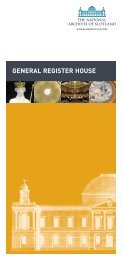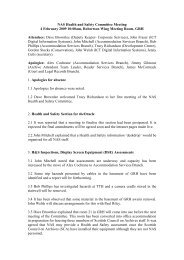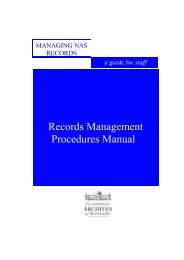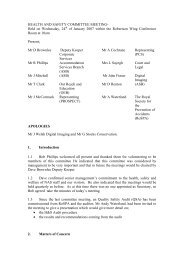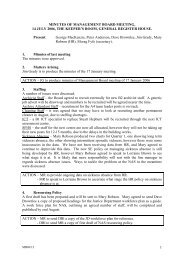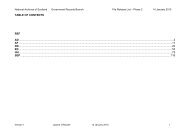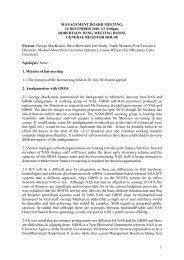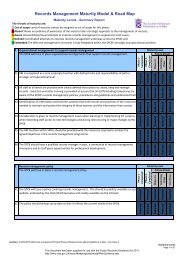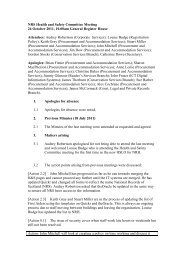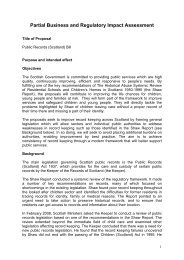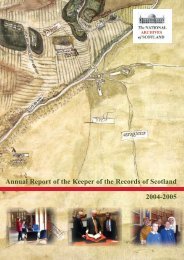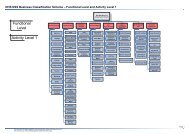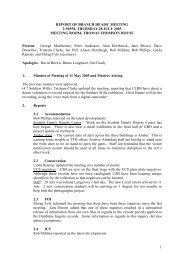Annual Report 2003-2004 - National Archives of Scotland
Annual Report 2003-2004 - National Archives of Scotland
Annual Report 2003-2004 - National Archives of Scotland
Create successful ePaper yourself
Turn your PDF publications into a flip-book with our unique Google optimized e-Paper software.
PAPER 3: SMITHSONIAN FOLKLIFE FESTIVAL, 25-29 JUNE AND 2-6 JULY <strong>2003</strong><br />
General Advice<br />
NAS continues to provide ad hoc records management advice to a wide range <strong>of</strong> public<br />
authorities and to provide speakers for various FOI events. In addition, general advice on records<br />
management, electronic records management, Scottish records legislation, data protection and<br />
Freedom <strong>of</strong> Information is being published in the new RecordKeeping area <strong>of</strong> the NAS website at<br />
www.nas.gov.uk/reckeep/. This area also includes sections aimed specifically at particular NAS<br />
stakeholders including government departments, agencies and non-departmental bodies. The<br />
content <strong>of</strong> the RecordKeeping area will be developed over time.<br />
Laura Mitchell<br />
Head <strong>of</strong> Government Records Branch<br />
The Smithsonian Institution is the world's largest museum complex and research organisation,<br />
composed <strong>of</strong> 14 museums and the <strong>National</strong> Zoo in Washington, D.C., and two museums in New<br />
York City. Every year the Smithsonian Centre for Folklife and Cultural Heritage organises the<br />
Smithsonian Folklife Festival which focuses on particular areas <strong>of</strong> the world. The festival takes<br />
place on the <strong>National</strong> Mall, a two-mile long area in the centre <strong>of</strong> Washington D.C. between the<br />
Capitol Building at the one end and the Washington Monument at the other. The 37th festival was<br />
held over 25-29 June and 2-6 July <strong>2003</strong>, and a total <strong>of</strong> 1,087,000 people visited the free event.<br />
The themes were ‘<strong>Scotland</strong> at the Smithsonian’, ‘Mali: from Timbuktu to Washington’ and<br />
‘Appalachia: Harmony and Heritage’.<br />
I was privileged to be part <strong>of</strong> the 140-strong ‘<strong>Scotland</strong> at the Smithsonian’ contingent along with<br />
Joanna Baird (Scottish Archive Network), Martin Tyson and Steve Chatterley (General Register<br />
Office for <strong>Scotland</strong>), and Jacqueline Hampson (Visit<strong>Scotland</strong>). We were representing the<br />
<strong>Scotland</strong>sPeople project, and our tent was called 'Ancestral <strong>Scotland</strong>'. The reason for this<br />
apparent confusion <strong>of</strong> titles is that 'Ancestral <strong>Scotland</strong>' was submitted to the Smithsonian several<br />
months before <strong>Scotland</strong>sPeople became the brand name for the Scottish Family History Service<br />
project. As the title suggests, we were helping visitors and giving them advice with their family<br />
history. We did this using three computers with broadband links, principally to<br />
www.scotlandspeople.gov.uk, but also to www.scottishdocuments.com and to<br />
www.ancestralscotland.com.<br />
We had a huge variety <strong>of</strong> people visiting our tent. Some were happy just to find out if their<br />
surname was ‘Scottish’ from a quick check <strong>of</strong> Black’s Surnames <strong>of</strong> <strong>Scotland</strong> or by entering their<br />
name into the 1881 Census search facility on www.ancestralscotland.com. Many others had read<br />
about us in the daily festival listing in the Washington Post and came prepared complete with their<br />
family tree, or with a specific person they were looking for. Some visitors (particularly the younger<br />
generation) realised that they did not have enough information and either immediately called their<br />
parents on a mobile phone, or else came back the next day armed with family information. Over<br />
the two weeks, we had a fair number <strong>of</strong> repeat visitors too. Indeed, one man who visited several<br />
times was almost in tears because he was convinced that a Scottish connection existed, but he<br />
couldn’t quite make the link.<br />
As well as the computers, we also had a large map <strong>of</strong> <strong>Scotland</strong> and panoramas <strong>of</strong> Edinburgh and<br />
Plockton on display. These were good talking points, and meant that we could also speak to<br />
people away from the computers. For instance, if we were successful in finding evidence <strong>of</strong><br />
people’s ancestors, they then wanted to know where they came from. This would then lead to<br />
interesting conversations such as ‘So what sort <strong>of</strong> a place is M<strong>of</strong>fat now? What are the main<br />
sources <strong>of</strong> employment for people there?’. Many people recognised the panorama <strong>of</strong> Edinburgh,<br />
and wanted to talk about holidays which they had enjoyed, or trips which they were planning.<br />
With the Plockton panorama, one woman actually knew who lived in each house!<br />
As well as being asked about genealogy, we found that we could be asked all sorts <strong>of</strong> questions<br />
about <strong>Scotland</strong>. For instance, ‘How much does it cost to fly to Shetland?’; ‘In Ian Rankin’s novels,<br />
what does “ca canny” mean?’. Just outside our tent there was a display board with general<br />
information about <strong>Scotland</strong>, with text in English, Scots and Gaelic which lead to some thoughtprovoking<br />
questions about language in <strong>Scotland</strong>.<br />
Speaking personally, I had two experiences which reminded me just how small the world can<br />
sometimes be. One morning while we were setting up the tent before the gates opened, a couple<br />
56<br />
57



